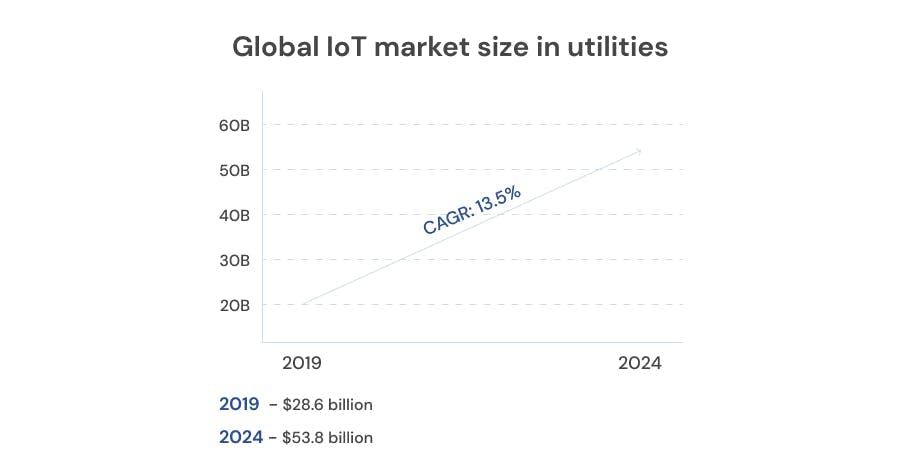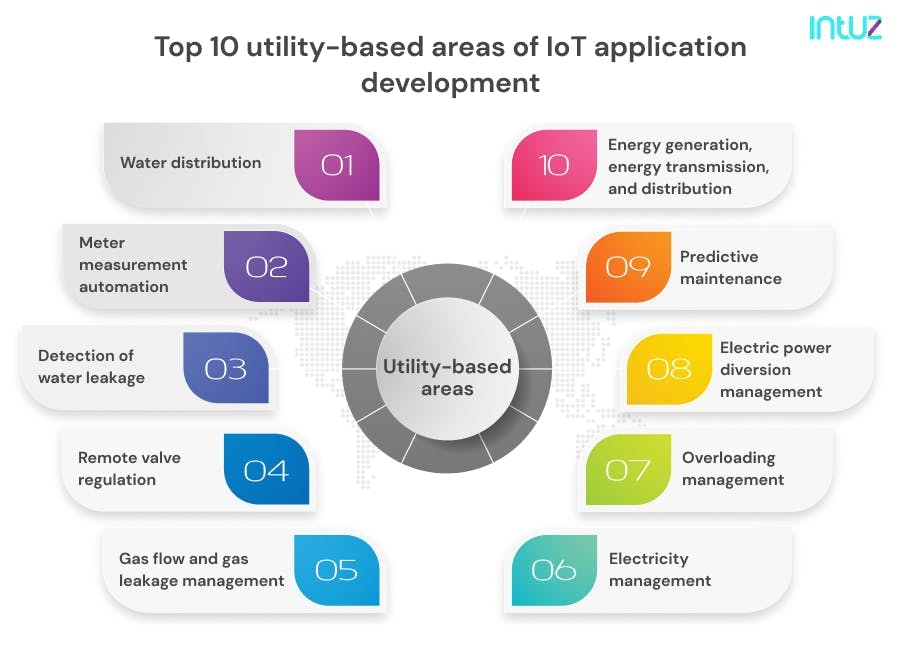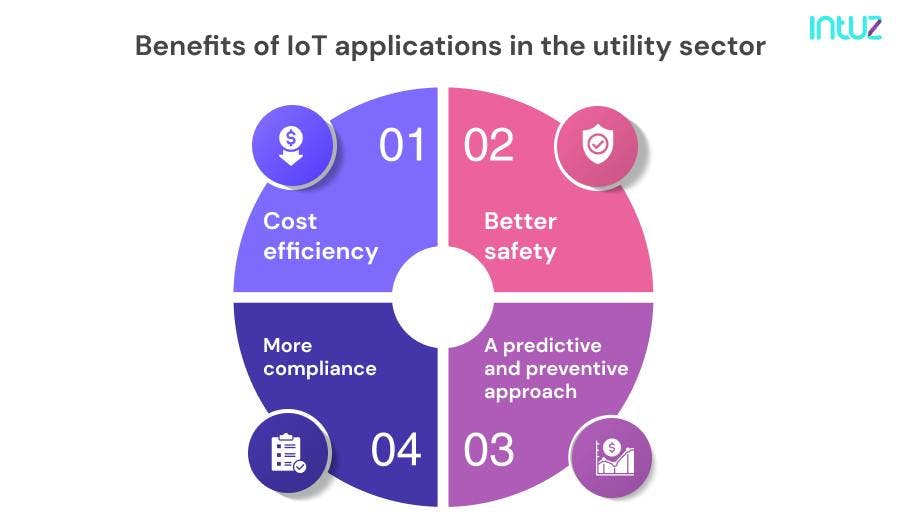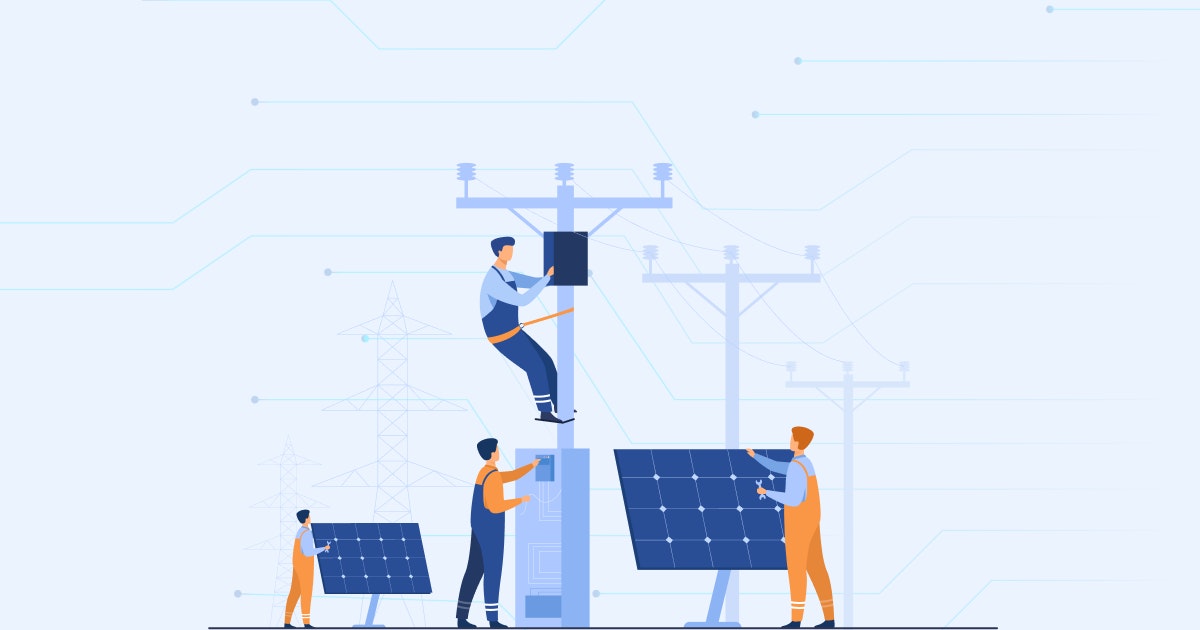The utility sector is undergoing tremendous changes as environmental regulations are gaining more importance. You must have come across buzzwords such as green energy, net zero, greenhouse gas emissions, and so on in the past decade.
Although renewable energy sources are becoming necessary to meet future goals, it is still vital to manage energy more effectively — because there is no planet B!
To reduce energy wastage, energy companies are actively adopting new technologies like IoT. Using the technology in concurrence with big data, artificial intelligence, and machine learning capabilities provides an even greater scope to satisfy customer needs.
Connecting the utility sector with IoT
Integrating IoT in the utility industry provides opportunities for all across the supply chain. It has become an integral part of modernizing utility programs, from energy generation to distribution networks for water companies or even waste management organizations.
The connected technology has specifically introduced many benefits to the utility sector. For instance, the IoT investment has increased focus on regulatory compliance, sustainability, and operational efficiency.
It has enabled direct communication links with consumers, enabling new services and a more engaged target audience. This was not possible before the advent of connected technology.
IoT has also contributed to the breakthrough of electric vehicles that will increase demand on grids. Near real-time data has led to more intelligent and innovative energy distribution planning. More importantly, IoT facilitates the growth of localized green energy production, which is the need of the hour.
No doubt connected technology has enhanced efficiency, economic value, and safety besides helping the utility sector achieve its sustainability goals. Let us take a look at how it is faring in this day and age from a statistical point of view.
Let's Optimize Your Utility Operations with IoT Solutions!
Let's Get StartedIoT in the utility sector: Market size, analysis, and forecasts
The IoT is expected to have a significant impact on the utility sector in the years to follow. The global IoT market size in utilities is estimated to grow at a CAGR of 13.5% from 2019 to 2024, thereby reaching $53.8 billion in total worth from $28.6 billion.

The technology is implemented across utility industries, including energy, water, wind, and power, throughout their generation, transmission, and distribution functions. It offers better security, asset management, workforce management, consumer side analysis, remote surveillance, resource management, and infrastructure management.
IoT-enabled sensors and devices can help with remote surveillance and monitoring. The collected data is helpful for consumer analysis to improve policies and optimize product quality.
The global IoT deployment in power systems is predicted to account for overall savings of $80 billion per year from 2016 to 2040. It is 5% of the global annual power generation costs of power plants and network infrastructures.
Smart demand response can also provide system flexibility, reducing investment in new electricity infrastructure by $270 billion by 2040.
The IoT software development technology helps utilities integrate various business processes that push the industry towards its growth phase exponentially.
That helps reduce the downtime in offering utility services, provides consumers a seamless user experience, and increases the overall efficiency of the business processes.
Top 10 utility-based areas of IoT application development
Global energy consumption is on the rise. The increased demand has helped the utility sector become the most profitable domain for doing business. However, despite generating billions of dollars worth of revenue, the industry faces multiple challenges daily.
That includes equipment failures, poor workplace safety, insufficient power maintenance, and so on. The IoT technology, in many respects, has helped manage the increasing demand for limited resources such as water and energy.
Let us see how it has offered respite to businesses through IoT app development in the utility sector:

1. Water distribution
IoT can improve the efficiency and accuracy of water management systems. Deploying automated consumption control systems ensures the proper distribution of water across the infrastructure. Widespread use for meters measuring flow in pipes or toilets with an attached reading device can help control the quantity of water consumed.
2. Meter measurement automation
The smart meter is a revolutionary device that stores all of your utility's information and can display it on an app or website. These advanced meter-to-cash options can help utility companies to save resources such as water or gas from wastage.
They can monitor usage patterns remotely and perform regular checks. Thus, using smart meters reduces the risk of human error and, in turn, preserves our valuable natural resources for the generations ahead relatively efficiently and sustainably.
3. Detection of water leakage
Water leakages can be prevented with the help of connected sensors, which provide prompt detection. Early warning signs allow for quick resolution and less costly repairs.
Timely identification of leakages helps control the wastage of water and avoid further spread. It also helps in saving money in repair and eliminates the chances of spoiling the surroundings due to seepage. Plus, the operations do not get disrupted, and work goes on smoothly.
4. Remote valve regulation
Customers no longer have to turn to utility specialists for help with water control operations. They can stop or restrict the flow themselves through intelligent valves. These valves can be regulated remotely using Internet-enabled devices or smartphones.
5. Gas flow and gas leakage management
The gas distribution system is a complex network of pipes and meters. The infrastructure needs to be monitored at all times to ensure safety and efficiency during consumption.
IoT solutions like smart meters offer increased preciseness of meter reading, gas flow control, and gas leakage management. Sensors can also be deployed around the infrastructure to ensure methane levels are controlled at all times.
The process of gas meter reading can also be automated to reduce human intervention. IoT-driven meters make it possible to review consumption details and visualize them without the necessity of interacting manually.
The technology saves customers time while providing them with a more accessible option for monitoring their usage information. Customers can use this information to track fluctuations and make decisions after studying trends over various periods.
6. Electricity management
Energy companies are taking advantage of the opportunities that smart grids provide through IoT software development. The technology enables utilities to handle prices more effectively and promptly and to facilitate remote management.
IoT detects errors in their systems, alerts the users to react quickly when needed, and stabilizes the system. They can use the information to forecast energy demand.
Energy production based on actual demand will allow such businesses to accommodate customer needs better while cutting costs for themselves at the same time.
7. Overloading management
IoT can be implemented to control a device's entire voltage system from one point with pinpoint accuracy. It helps address the issue of overload. These developments lead to increased efficiency for businesses as well as saving time on maintenance tasks. It minimizes power outages or other emergencies caused by overload problems at plants and facilities.
8. Electric power diversion management
IoT devices can help differentiate between authorized metered loads and malicious ones. The flow of electric current and voltage level can be monitored using sensors.
IoT application development saves losses to businesses and protects customers from potential damages due to power losses such as malfunctions of appliances. The system also manages power distribution to control usage for fair billing.
9. Energy generation, energy transmission, and distribution
The smart grid is a revolutionary advancement transforming the generation, transmission, and distribution of electric power. It uses IoT technology to detect changes in supply and demand. It uses a network of sensors and actuators to react autonomously. Operators can use the information for the precise management of loads on their energy transmission system.
10. Predictive maintenance
Utility providers for oil, gas, water, and electricity use equipment and machinery prone to unplanned failures, leading to business downtime. Hence, such businesses have to contact frequent inspections to find defects in their equipment.
However, these utility providers may also face equipment failures when some failures go undetected during periodic inspections. That is where deploying IoT sensors can come in handy. These are used to monitor vibration, track the temperature, and check moisture levels in real-time.
Moreover, these sensors can detect abnormal behavior in the machinery and track oil and gas transport pipelines and pressure valves and gauges to prevent any contamination or leaks.
Benefits of IoT applications in the utility sector
The recent and rapid growth of IoT devices has made many companies realize that they need to implement a more innovative solution to manage their resources. Not only is that cost-effective, but using sustainable products or systems has a favorable impact on the environment.
Thankfully, companies can use IoT by upgrading the utility infrastructure or operations with IoT integration. It provides them with the following benefits:

1. Cost efficiency
Using sensors to monitor utility assets and infrastructure helps organizations optimize their maintenance costs while upgrading their existing systems. Timely identification and rectification of issues help prevent costly repairs and reduce downtime.
IoT helps automate production, distribution, and supply operations and reduces labor costs. One can improve the performance and cost-efficiency of the distribution system by pairing different IoT utility sensors.
Data can be gathered for pipe pressure, electricity load, water quality, and so on and shared across the distribution systems of other utilities.
Advanced analytics allow operators to identify resource wastage and inefficiencies with high precision. They can eliminate them before problems show up.
2. Better safety
IoT is a great way to increase safety at different levels of the supply chain. The use of smart grid practices, condition monitoring, and preventive maintenance helps avoid accidents and reduces risks associated with utility operations by keeping equipment in good working order.
IoT also offers increased worker and infrastructure protection. For example, sensors can be installed on power lines or transformers. They automatically shut down upon detecting high-voltage problems or short circuits.
Thus, they prevent fires and potentially hazardous events, which helps stabilize the bottom lines of the companies in the long run.
3. A predictive and preventive approach
The future is coming at us quickly, and technology will only get more sophisticated. The key to success in the utility industry is not just knowing what's happening now — it is using the knowledge for predictions about where things are headed next.
The predictive and preventive approach is based on data. If you collect enough data, it can be used to identify patterns, trends, or other important factors about your assets in a given period.
The information can be used for forecasting purposes and planning your actions according to what's coming next. Reports suggest deploying digital systems backed with data analytics in a wind generation project can increase forecast accuracy up to 94%.
For example, the increasing demands of an electricity-producing and distributing company can be predicted using IoT data. Running it through AI-based tools will give enough information to optimize production across distributed energy resources.
Infrastructure managers can use these insights to prevent downtime or major failures. They can conduct preventive maintenance by predicting natural wear and tear in equipment.
Forecasting when maintenance is needed helps mitigate potential risks and reduces the costs involved in handling serious problems later.
4. More compliance
As the climate crisis is searing, regulations on energy companies are becoming intense. The market is changing rapidly, and utilities must adapt quickly to avoid facing stiff fines for non-compliance imposed by governments worldwide.
While there are fines in place, the focus is on reducing carbon emissions, and thus, governments are incentivizing green initiatives, offering savings to businesses.
Sensor technology and data solutions will help utility companies proactively address upcoming challenges. Using the IoT technology, they can collect operational data and continuously monitor it for compliance with regulations or carbon footprint requirements.
The data also helps them qualify for incentives. However, businesses need to develop effective strategies, collaborate with experienced professionals to implement IoT efficiently, and allocate a sufficient budget. Business leaders must find their place in the competitive market.
Complete Guide for IoT Product Development Stages!
Take a TourOver to you
IoT is being rapidly adopted across industries in today's world. It offers the benefits of preserving resources and improving capabilities. The utility industry can improve operational efficiency with resource allocation while also preventing leakages in precious energy resources.
Real-time data management tools help make processes proactive and effective. Plus, respect for nature and the earth's resources is essential if we want to live sustainably. IoT offers control over consumption and quality to save the share of future generations.
Supplemented by extensive R&D investments, IoT utilities will pave the way for profitability in the years to come in all probability. Businesses in the utility sector must arm themselves with an application that helps them achieve the desired goal.
Book a Free 45-minute Consultation with Our IoT Experts Today! Get a customized roadmap and strategies to leverage IoT for your utility business.

